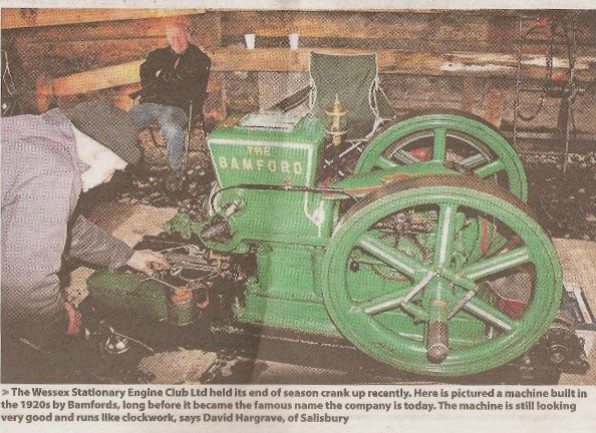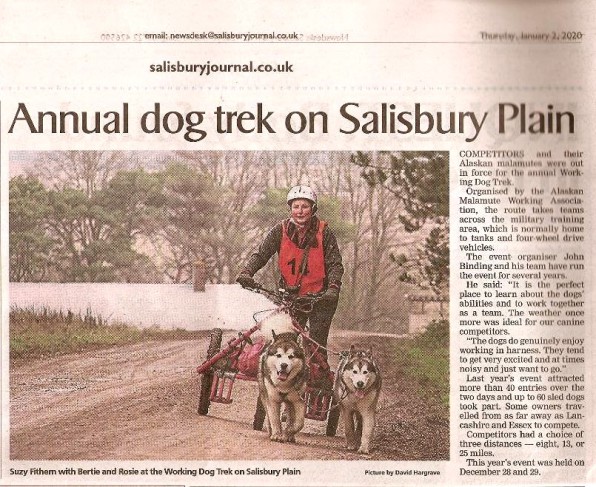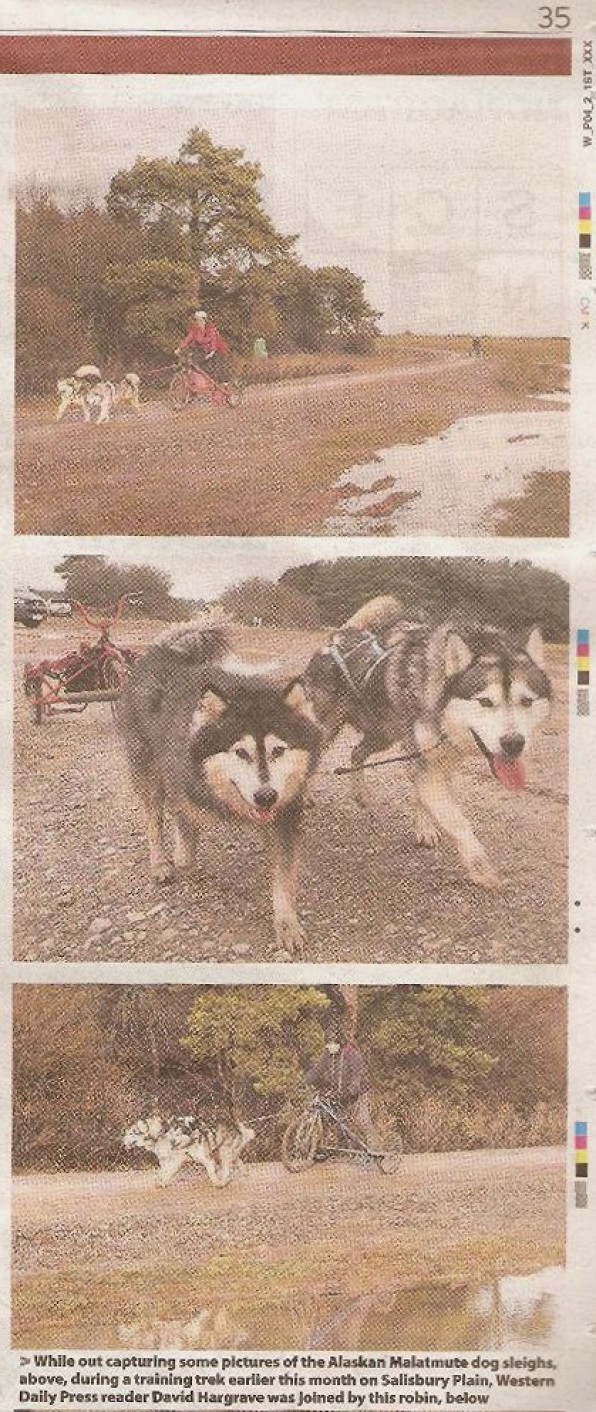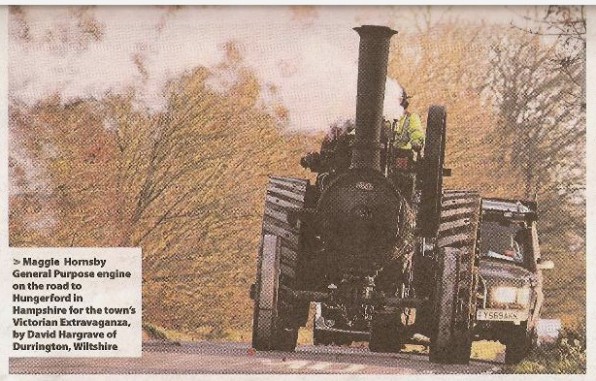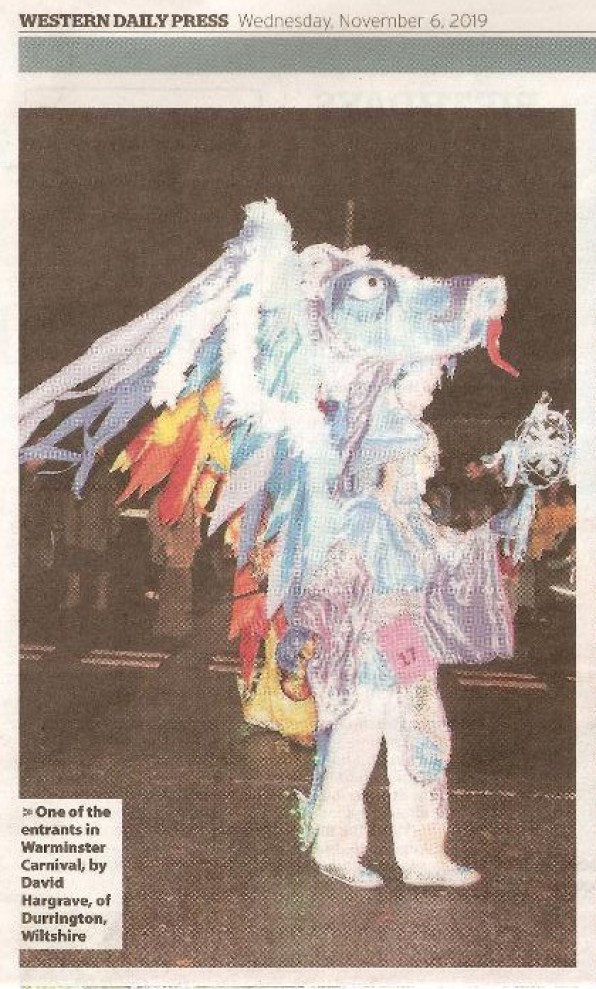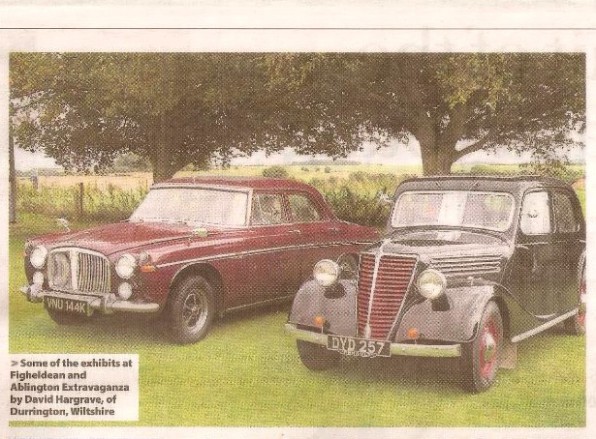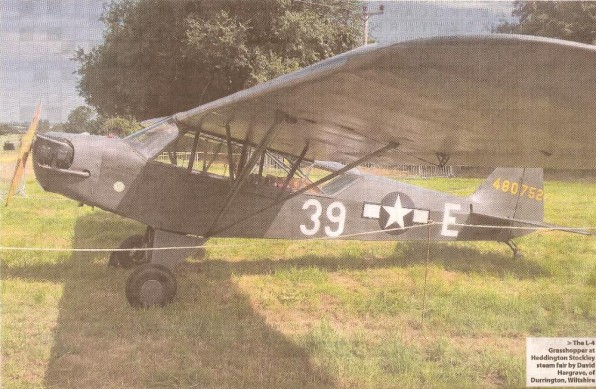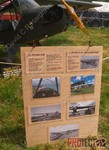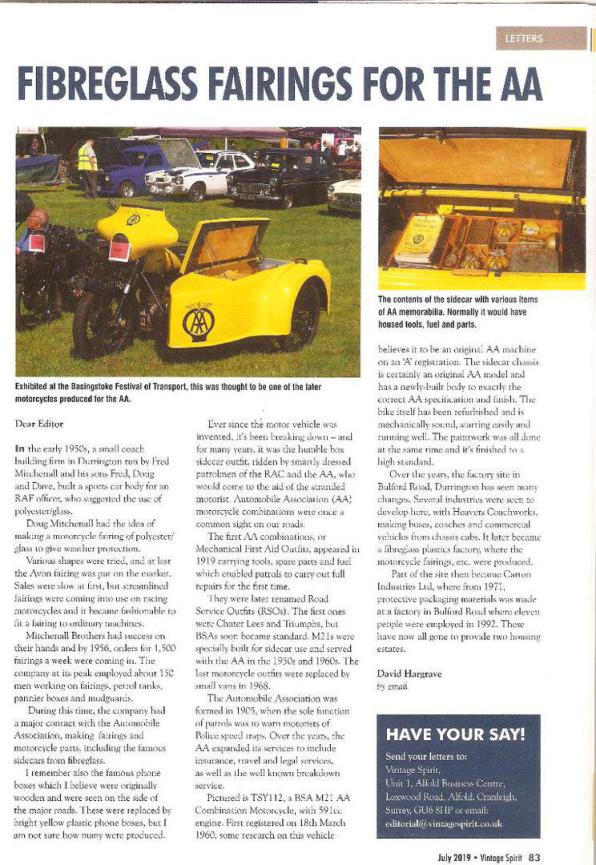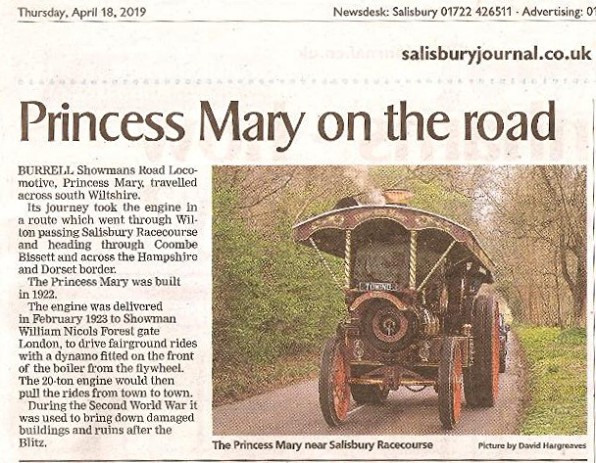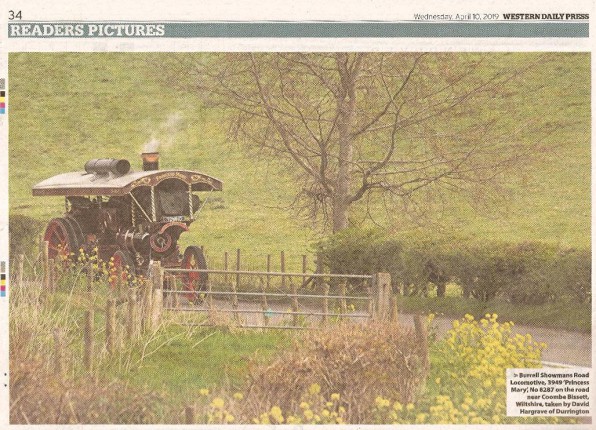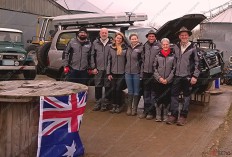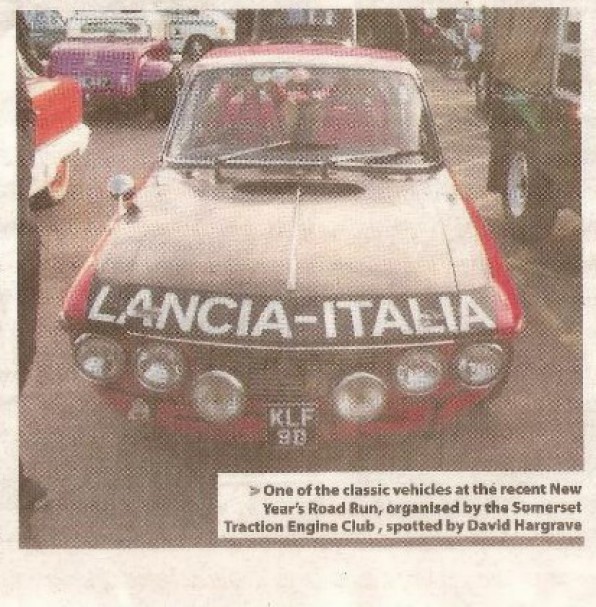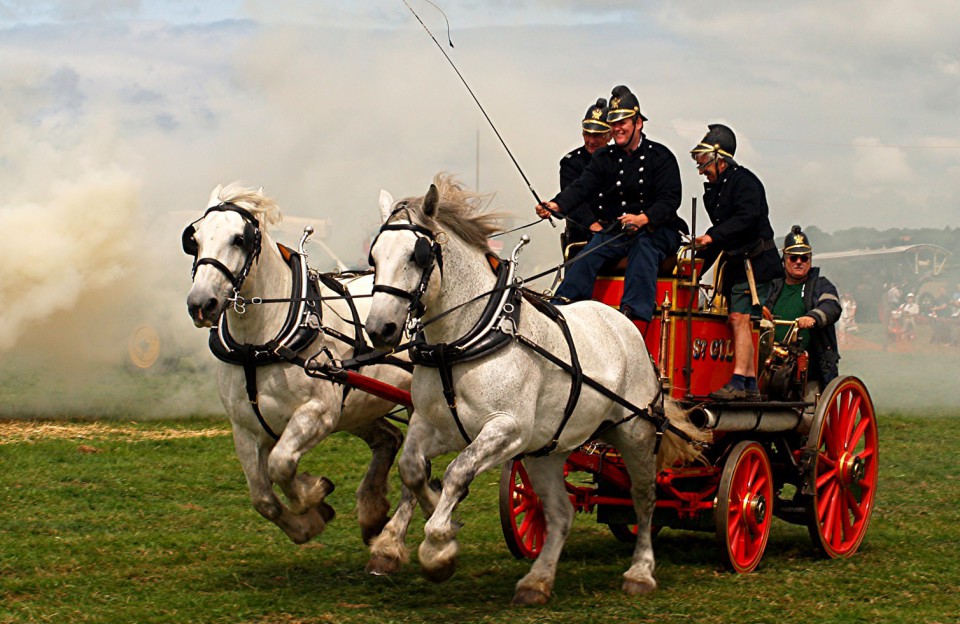
2019 Events
Escorting 'The Little Gem' to Salisbury for Salisbury Carnival - 25.10.19
I travelled with 'The Little Gem' from its base in Berwick St John to Salisbury for the evening carnival.
'The Little Gem' makes this journey every year, along with several other engines, that parade through the Salisbury City streets. This engine has been used over
recent years to raise money, for the Salisbury Hospital Stars Appeal Charity.
The roads used to travel to Salisbury, are to say the least not exactly wide!!! They are however very picturesque, it usually makes a lovely change to be in such
scenery in the bright sunshine. However, this time the weather was atrocious and the light was very dark at times, making the journey very hazardous.
We did meet a great deal of traffic, which did in most cases move over for us when asked. Others, who did not take the advice, soon found themselves reversing
back past the escort vehicle, to find a wider piece of road as originally advised, having suddenly seen several tons of steam engine in the road coming towards them, from the gloom! The crew
had actually taken the precaution of fitting LED warning lights on the front of the engine. They also rigged a fishing umbrella to try and stay dry but it was not that successful in the
terrible conditions. Despite these minor problems, we did make good time arriving in Salisbury as it became dark and the engine was ready to start the carnival.
The crew, Marcus and Michael are used to this engine as they run through the valley often. Although I do know the area, it was my first time on the road with 'The
Little Gem' and the crew in these weather conditions.
Meeting up with Richard Pocock the engine owner, Richard helped escort the engine through the narrow roads around the City.
The Route taken: Berwick St John, Alvediston , Ebbesbourne Wake West End, Fifield Bavant, Broad Chalke, Bishopstone, Stratford Toney, Salisbury Race Course.
Netherhampton, Quidhampton, Lower Bemerton, Churchfield Industrial estate, Salisbury Railway Station, Fisherton Street to the Central Car park.
This took around 4 hours and included service stops and water stops along the route. Top speed is usually around 6 MPH not bad for an engine of 86, that was never
built to be fast.
1933 Foster Traction Engine (VL4777) The Little Gem 5nhp Engine No 14638. Possibly one of the last single cylinder engines built in the UK.
The Magnum Carnival Club have been running for over 29 years and can been seen on the Wessex circuit of carnivals and also some of the Somerset Carnivals. They have
won endless awards for their Tableau float, which is something special to be seen.
Having travelled with the steam engines to carnivals and also attending many carnivals, I can reveal other interesting facts about the Magnum entry.
The tractor driver etc is none other than Gordon who is the very same tractor driver who moves all the engines at the GDSF. His wife Paula is also one of the
members on the float and is a Yeoman Warder in State dress uniform. They are often seen either organising or taking part at steam fairs etc during the summer.
Also involved are Laura Kimber and Chris Lawson who travel to the steam events with their Marshall BF 7865 BUILT 1911 Reg no 55924 8NHP and use the engine to haul the
charity rides trailers. Laura is this year a Yeomen Warder, wearing a red and dark blue undress uniform, worn for everyday duties in the Tower. Chris is on the road crew.
The carnival entry this year has made several efforts to reduce their impact on the environment with the Magnum Carnival Club ‘Tower of London’ cart.
Their cart was decorated with hundreds of red poppies made from recycled plastic bottles, and the bed of the cart was built using recycled plastic boards produced by
local company, Stormboard, who use waste plastic material to make the reusable boards. The use of these sheets allows Magnum to use the same flooring materials year after year, which they were
unable to do using traditional plywood floors.
They have further reduced their footprint by using all LED lighting, which has reduced their generator down from 100kva to just 6.5kva. In additon, they now only
require a single tractor to move the unit from town to town.
The engine was last out in public in steam with its stable mate Defiance at Oare, Wiltshire, in June 2017.
Gillingam Carnival - Cavalcade of Steam - 05.09.19
Very large crowds gathered in the streets, to see the procession in warm dry conditions, with the occasional minor shower.
The Cavalcade of Steam, headed the Carnival Illuminated procession, as it has in previous years.
The mastermind behind this steam event, Mr Nick Baker, was driving his Rushton Hornsby General Purpose Engine, with other invited guests.
This Carnival event clashes with Nick's birthday, who this year celebrated 75 years, also Mr Brian Burden who exhibits and drives Princess Mary celebrated his 75th a day
earlier than Nick!
Mr Nick Baker had 16 engines taking part, and these were at the head of the procession, which started about 7pm from the Brickfields Industrial Estate, along the High
Street, then up Queens Street to a dispersal area near Fairy Crescent.
Engines
Rushton Hornsby General Purpose Engine CJ 7207 Built 1924 No 12230.
The only surviving engine of this type in the Country.
The Rambler
Garrett Showman's Tractor - Rambler Works No.12115 - Reg. No. VW 5172.
The first owners of this engine were were Essex County .
1933 Foster Traction Engine (VL4777) - The Little Gem - 5nhp Engine No 14638
Possibly one of the last single cylinder engines built in the UK.
Owner Richard Pocock Of Shaftesbury Dorset.
Foden Wagon, 13316 'Sir Lionel', UU 1283 Built 1929
1910 Burrell 7 nhp Road Loco and Crane Engine - Old Tim - Works No. 3197 - Reg. No. AB 8904.
This engine was new to Screen Bros of Oldbury, Birmingham.
The photographs show Old Tim towing
Burrell Showmans Road Locomotive, 3949 'Princess Mary', NO 8287.
Exhibited by Karl and Brian Burden.
Marshall BF 7865 - Built 1911 - Reg no 55924 8NHP
Driven and owned by Chris Lawson and Laura Kimber
Robey Traction Engine No.29333 Wally Built 1910 AD 9899
Garrett Tractor Victoria - 4 nhp 4CD Tractor - No 34461 - Built 1924 - Reg No: PM 4795 - 1927.
Although built in 1924, this engine was supplied to W. and F. Bains of Blackham, Sussex in 1927
1944 Bought by Chris Lambert at Horsmondon, Sussex who converted it to a roller.
1955 Bought by Don Eastwood and in 1957 he converted the roller back to a tractor.
1905 Marshall Traction Engine (AF3520) The Countess 6nhp Engine No 43345 .
Wallis & Steevens Road Roller, 7844 "Old Ken", HO 6442
1924 Fowler DN1 Road Roller (U9493) Progress 5nhp Engine No 16134
Scale engines:
Albert Too Burrell Road Loco
Murphy McLaren
Foden Steam Wagon
Commercial Transport in Preservation Ltd - Autumn Road Run - 01.09.19
This run was open to commercial vehicles of all sizes and types, including public service vehicles aged 20 years and over. The run started at Salisbury Livestock
Market, Netherhampton, Salisbury. The route was approximately 65 miles taking in Wiltshire, Hampshire & Dorset.
The route was similar to other years with a run through Harnham and out along the A338 Bournemouth Road turning left at Downton. From here the road across the
Forest passing through Brook and onto Cadnam via the A336. Passing through Woodlands and Ashurst, the route turned right onto the A35 to Lyndhurst taking the A337 for New Milton and Milford on
Sea, where the lunch halt was held on the sea front.
The second part of the route headed towards Bournemouth along the A337 and A35 to Christchurch where a right turn through Burton Winkton and Sopley followed. Then
along the A3347 through Ringwood and onto the A338 towards Salisbury and back to the Livestock Market in Salisbury for an afternoon static display.
Vehicles
MRL 765 Austin K8 Built 1950
Body Tiverton Coach works C14F Owner Pete Davey
The K8 PSV was introduced in 1947, and is based on the K8 25 cwt 3-way van. Production ceased in 1954. This vehicle was new in 1950 and was originally operated by Chapman Brothers in Cornwall.
It is one of just five listed in the PSV Circle as being in preservation, of which only four are roadworthy.
It worked in Cornwall until 1987 taking children to school, on Wednesdays it took villagers of Rosenannon shopping.
The Interior is original and the engine is an A 70, 4 cylinder 2.2 Litre petrol engine.
1967 Foden S36 6 cylinder diesel ballast tractor
Reg. No. KFL 4E Serial No. 4HX63062138
This rather striking S36 was originally supplied new to Loades for Loads Ltd of Kings Lynn, from there it was sold to Ward & Smith of Leicester before residing with Yorkshire based company Harry Lyon Haulage. They used the vehicle for a number of years prior to loaning it to the Bowman Museum in County Durham. KFL 4E was then sold into preservation in 2010 and the then owner undertook a nut and bolt restoration.
Now in Hills Heavy Haulage colours of Botley.
Atkinson - ATV 121K – Ex fairground Towing tractor- trailer
E937 MEU 1988 Leyland Freighter
1957 Austin FX3 London Taxi XKR 368A
HCH 771K Commer Lorry Compton of Berwick St John
Home & Workshop Machinery - VNP 545G
1968 Volvo 86 Bubble Cab
The Westend Garage, Bruton had five vehicles on the road run. The 'military division’ has grown and is popular and much requested around the West.
They have managed (with some degree of success) to get a 1940 Morris Quad (complete with limber and 25 powder gun) refurbished and up and back on the road. Running
speed was alright 70 years ago but not quite up to today’s standards. When out with its big brother the AEC matador and 5.5” howitzer they make up an impressive sight.
The five vehicles were as follows:
641 XUX 1943 AEC Matador
1954 Austin Champ JGU 134K
1940 Morris Commercial Quad WRK 995K
NYB 554P Mini Pick up
HOR 203E Limmer and Trinidad/ Foden
Retro Transport Show & Fete - 31.08.19
Save the Ablington Woods Project.
www.justgiving.com/crowdfunding/ablingtonwoods
This was held on Figheldean playing field and was organised by several villagers who have formed their own committee to save Ablington Woods. A great old fashioned family fun day which included a BBQ, vintage vehicles, games, bar, craft stalls, tombola and even a cafe.
An excellent event for a very small village, with some very interesting vehicles on display.
The tractors have been seen over the years supporting local charities in the area at shows and road runs etc.
Swift Two Seater Motor Car
Reg Number: H 51. Year : 1904. Make: Swift Body: Two-seater. Cylinders: 1. Horse Power: 7.
The Swift Motor Company made Swift Cars in Coventry, England from 1900 until 1931. It grew progressively from James Starley's Coventry Sewing Machine Company, via bicycle
and motorised cycle manufacture.
The cars ranged from a single-cylinder car in 1900 using an MMC engine, through to a Swift-engined twin-cylinder 7-horsepower light car in 1904. A 3-litre model in
1913.
In 1904, the Swift Cycle Company Ltd. made a single-cylinder 700 cc car (possibly a voiturette) which had a cloverleaf emblem on its radiator, an emblem that was adopted by all the cars. In the years 1909–11 another single-cylinder 7 hp car was manufactured, this time with 1100 cc (105mm bore and 127mm stroke). This car was also sold by Austin as the first Austin 7.
The first Swift car of the conventional type was the twin-cylinder 7-horsepower, later 10-horsepower, of 1904. This was shortly afterwards joined by the four-cylinder
12/14, which continued in a bewildering number of guises until the First World War. These cars were entirely built at the Swift works, with the exception of the engines which were built in Coventry
by Messrs White and Poppe.
A larger car, the 15, with a 3-litre engine was added to the range in 1913, and this continued to just post-war. During the First World War, car production
ceased.
After the war ended, the Cycle Car company was merged with the main company as Swift of Coventry. A Harper Bean & Sons, who also made Bean Cars, bought 50% of Swift's
ordinary shares in 1919, but got into severe financial difficulties later that year, seriously affecting the company's finances.
The Swift range was simplified with the excellent 1100 cc 10 continuing and joined by a 2-litre 12 with a 4-speed gearbox. A new 10 was launched in 1923 as the Q type
with coil ignition, electric starting, optional front wheel brakes and a top speed of 55 mph (89 km/h). Standard front wheel brakes were added in 1926 and the engine was bored out to 1190 cc to
become the P type. The engine grew again to 1307 cc in 1929 when the car became the P2.
From 1924 Swift supplied Q type engines for the Ariel Ten light car. This model continued until 1925, when Ariel ceased making cars to concentrate on
motorcycles.
In 1925 the Swift 12 was replaced by the 12/35 with front wheel brakes, plate clutch plus an increase of 24 inches (610 mm) in the wheelbase.
The last Swift car was the 1930 Cadet, which was an attempt to compete with the £100 cars. This had an 850 cc Coventry Climax engine and a price of £149 for the tourer
and £165 for the saloon.
But Swift was too small to compete with the likes of Ford and Morris and closed in 1931 after its suppliers foreclosed on its debts.
Coventry Climax was left with a number of engines for the Cadet model, which it used as the basis of its Second World War fire pump engine designated FSM, the SM standing
for Swift Motors.
Mr Robert Solomon brought his 1904 Swift motor car to the show. It has competed in several London to Brighton runs over the years.
1962 Fordson Dexta with a Roadless Four-Wheel Drive Conversion
Somerset Steam & Country Show - 19th, 20th and 21st July 2019
Friday
On Friday I met up again with 'Margaret' the ploughing engine, which does happen several times a year. I have known 'Margaret' for several years and was very
pleased a few years ago to steer this massive engine around the plough field. Richard, who often drives 'Margaret' had invited me on board to take some photographs and we ended up driving
across the plough field to set up the plough.
This weekend Richard greeted me with a challenge, he intended to take the massive engine through Langport High Street to stop momentarily underneath 'Margaret's flag', a
beautiful flag with a lovely photograph of 'Margaret' sponsored by the Somerset Traction Engine Club.
Every summer the Langport Flags come out to adorn the High Street for the summer months. For 16 weeks each summer, these colourful flags decorate the main streets
of Langport. They are part of a Langport and Huish Episcopi Youth Group project, which has grown considerably over the last few years. Other groups and schools are now involved including
Huish Primary and Huish Academy, Hambridge School, RAISE and The Ridgway Hall Disability Group.
Our aim was to get a photograph of 'Margaret' under 'her' flag but this proved to be too difficult. As it was a Friday and the start of the school holidays,
the town was already very congested, almost gridlock. The main thing was 'Margaret' made the journey, stopped in the town centre and drove through, passing under 'her' flag.
You will see due to modern technology, I was able to get the flag and the engine in almost the same shot!
Margaret - Fowler "Margaret" Built 1870, No 1368 Reg No AL 8468 12nhp the 'Salvage Squad' engine. One of the Beeby Brothers fleet of steam ploughing engines
from Rempstone. It was re-boilered in 1920. Now owned by Andrew Melrose who has carried out extensive restoration works, including the taking part in the television programme The Salvage
Squad in 2002.
Road Run Friday - to Martock and Yandles Woodworking Centre
Despite some heavy showers, as always, the road run was very well supported by all types of vehicles. The road run left the showground going to Martock and Yandles
Woodworking Centre with a trip back towards Somerton to Harry's Cider Farm. Four engines took part in the road run along with many other tractors and various vehicles.
Yandles Woodworking Centre is one of the largest shops of its type in the country, nestled in the village of Martock, near Yeovil and well worth a visit.
Harry's Cider is an award winning artisan cider made from 100% juice, crafted by cidermakers.
Princess Mary - Burrell Showmans Road Locomotive, 3949 'Princess Mary', NO 8287 - ‘Princess Mary’ was built in 1922 and exhibited by Charles Burrell of Thetford,
Norfolk, at the Smithfield show Islington.
Twilight - Tasker “Twilight” 5 nhp tractor no 1513 1912 reg no IB 1597
Countess - Garret “Countess” 4CD Showmens Tractor1917 no 32969 reg no BJ 3280
Marshall 8 Nhp traction engine 1911 no 55924
Saturday/Sunday
The Wimborne St Giles Horse Drawn Fire Engine carried out a spectacular display on both days. This is a 1908 Shand Mason Horse-drawn Steam Pump, one of the
earliest fire pumps.
In 1829 a steam-pump engine was invented by John Braithwaite, a London engineer. It had a 10-hp engine that could raise steam in 13 minutes, pump 170 gallons a
minute and send a jet 90 feet high.
In 1858 a Mr Shand, partner to Mr Mason built a similar engine but with a shorter wheel-base and a footplate at the rear for the boiler operator requiring 3 horses to
pull it.
Improvements were made and in 1886 they brought out a lighter model requiring only two horses and capable of raising steam to working pressure in 9 minutes and producing
a jet to a height of 150 feet.
These 'patent variable-expansion engines', with single or double cylinders were in production up to 1910.
The boiler was kept near working temperature with a gas ring, the fire being laid with coal at the bottom and wood and paper on top.
At the sound of the alarm the gas ring was inverted and the fire ignited and drawn up by a forced draught with foot bellows or chimney fans as on the St Giles
engine.
The 1666 Great Fire of London stimulated development of fire engines. Insurance companies founded in the 18th century attended fires only, with their own engines
but only in buildings insured by the them and showing the company sign.
This machine from 1908 was a private engine, on the Earl of Shaftesbury's, Wimborne St Giles Estate. The machine was purchased by the Earl following a disastrous
fire in 1907 in the village Church, when plumbers mending the lead roof left it smouldering. It was purchased after the village's manual pump proved to be of no use. It went on to serve
the village until 1948.
This is a 1908 Shand Mason Horse-drawn Steam Pump ordered for the protection of St Giles House and Wimbourne St Giles village in Dorset.
Shand Mason were able to deliver the engine in just 8 weeks with everything except the horses for around £400.
This machine remained in service until 1946, when it was sold for scrap, William Turner of Parkstone an old vehicle collector bought the engine.
In 1957 Tom Sampson was asked to horse the engine at the Cranbourne festival. This was the start of the relationship of the Percheron horses and the St Giles
Engine.
In 1987 it was purchased from William Turners daughter. The St Giles engine is a double vertical steam pump, pumping 260-300 gallons a minute.
It has featured in several TV programmes and was at the Hampshire Fire Headquarters when opened by HM the Queen.
The two Percheron horses drawing the engine were Verveine and Vitamin both 10 years old and both imported from France. They can be seen at shows including the Great
Dorset steam Fair. They undertake ploughing , driving trials amongst other things.
The current owner John McDermott has ploughed with Percheron horses since his late teens. His horses are frequently seen demonstrating the St Giles steam fire
engine at shows and events. He competes very successfully in heavy horse driving trials and he has won many trophies.
1932 Commer 20/25 Breakdown Truck NAS 856
A 1932 Commer 20/25 Breakdown Truck Reg number NAS 856 - Trade plates GDS 474 ref to G&D Skinner and the date of their wedding.
Evening Road Run Saturday - to 'Eli's' - Rose and Crown
This is an unofficial road run to the Rose and Crown and very well supported.
Burrell Showmans Road Locomotive, 3949 'Princess Mary', NO 8287 took part in the road run in addition to:
King Harry - Mclaren Road Loco 8 Nhp no 1181 18 ton compound built 1912 reg BF 4595
Wallis Stevens 10 ton road roller no 7844 reg HO 6442
Burrell 2767 Single crank compound 6 NHP 9 3/4 tons Reg YA1683
Cornish Maid - Burrell reg AF 3518 Built 1919 no 3816
Avelling & Porter Road Roller 7857 SH 4274 Built 1912 Class, BHO. Cylinders, Single. NHP, 5.
Berkshire Lady - Fowler BB1 12 Nhp Plough engine no 15164 built 1918 reg WR 7185
Tiger - Sentinel Super steam wagon no 5260 Built 1924 reg RS5540
The Wolverhampton Wanderer
Mark Fry took the engine out on the road for a run on Saturday evening through Langport.
Fowler & Co. (Leeds) Ltd. 1929 Fowler 8nhp 21 ton B6 Crane Engine
Works no. 17212 - Reg. no. RF 6092. 1929 Fowler 8nhp
This engine Is still owned by the Wife of the late Len Crane. She has very kindly allowed it to tour and be shown at events by Mark Fry who has entertained many
people with this engine all over the country.
This engine was a star of Peaky Blinders a British crime drama television series primarily set in Birmingham, in the aftermath of World War I.
Heddington & Stockley Steam Rally & County Fair - 6th & 7th July 2019
As always, the sun shone for the Heddington & Stockley Rally & Country Fair. A vast number of visitors came to see the exhibits which exceeded previous
years.
With displays of steam engines large and small, vintage cars, commercials, motor cycles, tractors, displays of falconry, wood carving. horse ploughing, thatching ,country
crafts fun dog show, fun fair, children’s area and even an areoplane the two day event had something for everyone.
L4 Piper Cub
This aircraft is now quite local, it was recently at the museum at Boscombe Down and was flown into the steam fair site at 07.00 on the Friday before the
event.
For the Army Ground Forces, aerial observation remained a concern. An ideal example of an aircraft that could provide the necessary observation was the Piper J-3
Cub, destined to become the L-4 Grasshopper. Air Corps officers, who tended to be more focused on the newest and most innovative aircraft, deemed the Cub technologically obsolete. It offered
ground forces simplicity and reliability paired with ease of operation, repair, and maintenance. Along with the civilian availability of the Cub and similar aircraft, two other critical
elements emerged to make what became the Air-Observation-Post program possible. First, the Army Signal Corps began to field new lightweight FM radios providing static-free, reliable air to
ground communications; Second, the field artillery made the battalion the primary unit for delivering indirect fire. This was coordinated via a battalion fire-control centre, whereby firing
data could be computed to permit multiple guns to accurately fire simultaneously on the same target. These three factors enabled Army ground forces to anoint adversaries with a storm of fire and
steel.
Team Deutz
Whilst walking around the site at the weekend, I met with Peter and his the crew from Team Deutz from Calne, Wiltshire and their pulling tractor Mean 'n' Green.
They had recently won cups in Scotland and Ireland. I had an opportunity to photograph them with the lovely Megan on a previous meeting at the Wiltshire Steam & Vintage Rally at
Rainscombe Park, Oare.
This weekend they were in action at their local event and Peter and his crew kindly came and let me know how things were going between his runs. Following a few
problems, Peter and his crew achieved second place on Saturday.
I watched some of the action and Peter preparing and completing a full pull on the Sunday, which put him into the finals.
Hornsby General Purpose Engine, 6557 'Maggie', FL 2598. Built 1887
One of seven to survive from the early period, the others all survived in either Australia or Tasmania, where they worked.
Supplied new to Ratcliffe &Co Derby and later with Harry Gibbons & Sons of Caster, Peterborough for contract threshing for 38 years.
In 1963 owned by DGT Hackett of Ross On Why for preservation it then went to Bob Markham in September 1977
Bought in 1999 and restored.
Sam & Tilly
The two most beautiful Competition Plough Horses I have seen.
Sam is a Bay Clydesdale x Shire gelding and Tilly is a Shire filly. Tilly joined the team to work with Sam to allow the beautiful Poppet to go into retirement, as
it used to be Sam & Poppet! Poppet is now enjoying retirement.
They are seen at many steam rallies, country shows and ploughing matches all over the country.
Sam & Tilly put on a brief display in the heat. No long lens here, these horses see me so often.
I understand from their Facebook page they also cover proms and weddings, what a way to travel!
Oh yes, I have also seen a certain gentleman as a Fireman on the The Wimbourne St Giles Horse Drawn Fire Engine! A multi talented team, not fogetting the First Class Groom who I understand is responsible for their beautiful harnesses and regalia amongst other things!
Threshing & Wood Saw Demo at Wiltshire Steam & Vintage Rally - Rainscombe Park, Oare - 08.06.19 - 09.06.19
1916 Wallis and Steven Expansion Agricultural engine Progress. Owned by Roy Herring, manufactured in 1916 for the ministry of munitions. It was then offered
to the NTEC by member Walter Edney to help raise funds by way of a raffle. This was won by a 14/15 year old who chose to have £100 in cash instead, as his family had nowhere to keep it.
It was purchased by its present owner in 2000 and has been extensively restored.
Alfred Peace Racksaw Bench 190. Purchased by Roy Herring from a farm yard near Princess Risborough Bucks in 1970. It was originally a static bench with
a manual hand feed but the owners made it portable,by the construction of a wheeled chassis to which the bench was subsequently fixed. In 1993 an automated feed system from a similar bench was
fitted, this basically consists of a series of belts, pulleys and cogs. The combination of these items offers several cutting speeds as well as a forward reverse rapid traverse of the
table.
Wiltshire Steam & Vintage Rally - Rainscombe Park, Oare - 08.06.19 - 09.06.19
Whilst walking around site on Saturday I met with some chaps from Team Deutz from Calne, Wiltshire and their Pulling tractor Mean 'n' Green. They had recently won
cups in Scotland and Ireland and I had an opportunity to photograph them with the lovely Megan!
Please see information below taken from: http://pullingworld.blogspot.com/2018/03/new-component-limited-pro-stock-in-uk.html
The next stop for them is the Heddington and Stockley Steam Rally & Country Fair. Give them a cheer!
New Component Limited Pro Stock in UK
The Team Deutz UK from Calne, Wiltshire, in South West England have built a new Deutz DX 110 Component Limited Pro Stock Tractor in 2017.
The Tractor is a 3.5t / 7700lbs. Limited Pro Stock, same rules as a normal Pro Stock, but with an engine displacement limit of 404cui. The British Team compete with the
South West Tractor Pullers Association and the North East Tractor Pulling Club for points in the UK Pro Pulling Championship.
Team Deutz UK was started in 2002 by Pete George from Wiltshire, South West England with the Deutz 8006 machine called, Mean ´n´ Green". The Tractor was all ready
built and over the years they improved on what they had. In the Winter of 2013/14, the guys rebuilt the whole front end with the help of Ed Bateman of Major Madness. With the fresh new
look, the Tractor was renamed into, Mean ´n´ Green DX Generation". After 2 strong seasons at the final round of the 2015 season, they broke the gearbox, with this and the fact the Tractor never
ran in a straight line, the Team decided to rebuild the Tractor into a Component Tractor. Over 2016/17, the Tractor was rebuilt into a Component Tractor with help of Steve Cox and at the later part
of the 2017 season they were able to make some test passes with great results. The whole Team is run on a very tight budget and have to be clever to keep at the top of the class without spending a
fortune or pushing it to far to break parts.
The new Component Limited Pro Stock received a new homemade 4mm steel wedge frame with a american spec built steel rollcage by Ed Bateman, homemade steel wheelie bars and
a DAF Truck rearend. The Deutz DX 110 hood isn´t original anymore. They built the hood from aluminium and is larger than the original DX 110 hood. The sheet metal fenders of the Pro Stock are
original Deutz.
The Team Deutz UK bought the Truck rearend for their new machine from Piet Hagens in the Netherlands. Piet is the owner and driver of the turbocharged Transmash V12
powered Light Modified Tractor called, One Dirty Doz 'n'. The rearend has a original DAF center section with a DAF 2255 needle bearing differential, a DAF ring and pinion gear and machined
aluminium Mercedes planetaries carrier housing with Mercedes planetaries. The new ride also got a Fuller 5 speed gearbox with a costum built gearbox housing by Steve Cox, a self built clutch
bell housing and a 2 disc clutch built by Chris George. The rear wheels on the Mean ´n´ Green DX Generation are a set of cut Goodyear 20.8 x 38´´ inch tires on light steel rims. The Goodyear tires
were cut by Pete George.
The new Limited Pro Stock is powered by a Deutz BF6L 913 power plant with 6.1l / 378cui. on diesel fuel. The engine received a lots of changes. The engine has a
original Deutz cast iron block with bigger sleeves, original Deutz rods with KS Kolbenschmidt pistons (machined with their own design), a Deutz crank with KS Kolbenschmidt bearings, a flowed Deutz
head with a Performance Design camshaft, a Holset HC3 Performance turbocharger built by Universal Turbos, a stock intake manifold and a costum built exhaust manifold by Ed Bateman, a homemade
aluminium Intercooler and a Bosch P-pump with 13mm elements by John Sowerby. For the upcoming season, the guys from UK will make some few more changes on the engine. They want going over to electric
fans and changing to a better exhaust system.
Mike King arrives at the Wiltshire Steam & Vintage Rally - Rainscombe Park, Oare - 07.06.19
Mike King travelled on his Ford tractor via Salisbury Plain to Oare, from his home in Milston over the downland, There was a major military exercise on all around him,
but he was on the byways, so perfectly within his rights to use that route.
We sat in his caravan this morning laughing about his journey, as he was setting up his tractor stand at the show.
It was very different weather today compared to yesterday, even Mike's dog was not keen to be outside, as we sat drinking a cup of tea!
Despite some heavy rain showers the show is building up and engines are arriving.
Mike and his band of Brothers set up a different display each year of various makes of tractors, this year it was John Deere.
Most of the family are Ford owners and it is amazing how many contacts they have, enabling them to put on a large display of makes of tractors of all models and
ages.
Lady Jean arrives at the Wiltshire Steam & Vintage Rally - Rainscombe Park, Oare - 07.06.19
I took these photographs this morning at Rainscombe Park. Despite some heavy rain showers the show is building up and engines are arriving.
Lady Jean
Owners: Robert & Phillip Johnson
New in July 1915 to Harry Adcock & Sons, Timber Merchant of Corby Glen, Lincolnshire. Used for timber haulage and general road haulage in the Lincolnshire
area.
1st Registered CT4817 in September 1921.
1930’s – 1950’s used for timber haulage & general purpose work by several owners in the Lincolnshire/Leicestershire area.
Owned in preservation by Ronald Deamer of Chatteris, Cambridgeshire from 1964 to 1971.
Purchased by present owners in June 1971.
Regular attendee at many annual shows from 1971-1978 including Hungerford, Woodcote, Appleford, Fairford & Knowl Hill etc.
Extensive rebuild carried out from 1979 to 1984, including new fire box, boiler repairs, new tube plate, tender repairs, new belly tanks, new canopy, front spring,
bearings and gears etc. Work carried out by the owners in Derek Marder’s yard Andover.
Rear wheels repainted and Quad tracks fitted May 2011.
Believed to be the only surviving example of a 7NHP compound Clayton & Shuttleworth.
Rob tells me he will be taking the engine to The Great Dorset Steam Fair this year. It would appear it has never been to the Dorset event and will be one of many
machines taking part in the engines from the City of Lincoln, special feature.
Last October is was the support engine for the Tour of Swindon with The Great Dorset Steam Fairs WW1 Howitzer (phographs included below).
Basingstoke Festival of Transport - 12.05.19
Basingstoke Festival of Transport is delivered in partnership with Basingstoke and Deane Rotary Club and Basingstoke Thornycroft Society with support from Basingstoke and Deane Borough Council.
The War Memorial Park was once again filled with over 900 vehicles. As in previous years, there were a huge range of vehicles on static display, including: classic,
vintage, commercial vehicles, fire engines and military trucks.
AA Motor Cycle Fairings
In the early 1950’s, a small coach building firm in Durrington, Wiltshire, run by Fred Mitchenall and his sons Fred, Doug and Dave, built a sports car body for an R.A.F.
Officer, who suggested the use of polyester/glass.
Doug Mitchenall had the idea of making a motor-cycle fairing of polyester/glass to give weather protection.
Various shapes were tried, and at last the Avon fairing was put on the market. Sales were slow at first, but streamlined fairings were coming into use on racing
motor-cycles and it became fashionable to fit a fairing to ordinary machines.
Mitchenall Brothers had success on their hands and by 1956 orders for 1,500 fairings a week were coming in. The company, at its peak, employed about 150 men working on
fairings, petrol tanks, pannier boxes and mudguards.
During this time the company had a major contact with the Automobile Association, making fairings and motor cycle parts including the famous sidecars from
fibreglass.
Over the years the site of the factory in Bulford Road, Durrington has seen many changes. Several industries were seen to develop here, with Heavers Coachworks,
making Buses Coaches and commercial vehicles from Chassis cabs. Then later it become a fiberglass plastics factory, where the Motorcycle fairings etc were produced.
Part of the site then became Carton Industries. From 1971 protective packaging materials were made by Carton Industries Ltd. at a factory in Bulford Road where 11
people were employed in 1992.
These have now all gone to provide two housing estates.
I also remember the famous phone boxes which I believe were originally wooden and were seen on the side of major roads. These were replaced by bright yellow plastic
phone boxes, but I am not sure how many were produced.
Ever since the motor vehicle was invented, it’s been breaking down – and for many years it was the humble box sidecar outfit, ridden by smartly dressed patrolmen of the
RAC and the AA (founded in 1901 and 1905 respectively)
Automobile Association (AA) motorcycle combinations like this were once a common sight on our roads.
The first AA combinations, or Mechanical First Aid Outfits, appeared in 1919 carrying tools, spare parts and fuel which enabled patrols to carry out full repairs for the
first time.
They were later renamed Road Service Outfits (RSOs). The first outfits were Chater Lees and Triumphs, but BSAs soon became standard. M21s, like this, were specially built
for side-car use and served with the AA in the 1950s and 1960s. The last motorcycle outfits were replaced by small vans in 1968.
The Automobile Association was formed in 1905, when the sole function of patrols was to warn motorists of Police speed traps. Over the years the AA expanded its services
to include insurance, travel and legal services as well as the well known breakdown service.
This photograph shows a motorcycle exhibited at the Basingstoke Festival of Transport, which is thought to be one of the later motorcycles produced for the AA.
TSY112 1960 BSA M21 AA Combination Motorcycle
AA Motorcycle Sidecar Combination
Manufacturer: BSA
Model: M21 with AA sidecar
Condition: Nearly Concours (2)
Engine: 591 cc
Year: 1960
First registered on 18th March 1960, some research on this machine which is believed to be an original AA machine on an "A" registration. The sidecar chassis is certainly
an original AA model and has a newly built body to exactly the correct AA specification and finish.
The bike itself has been refurbished and is mechanically sound, starting easily and running well. The paintwork was all done at the same time and it's finished to a high
standard.
The Bill Targett Memorial Steam Rally - 11th & 12th May 2019
An event for the family & enthusiasts in aid of the Wessex Cancer Trust and Isle of Wight Air Ambulance.
There were steam engines, classic cars, motorbikes, stationary engines, tractors and much more to see. With an arena, trade and craft stalls and food vendors there
was something for all the family.
Due to a previous commitment, I was unable to attend at the weekend but I did manage to catch up with some of the engines travelling to the rally field on the
road.
The Urchfont Scarecrow Fesival - 4th - 6th May 2019
This was the 22nd year of The Urchfont Scarecrow Festival and featured more than 50 themed scarecrows made and displayed in the village.
With funds from the sale of trail maps and a prize draw, the event raises cash for local causes and a large donation is also given to the Wiltshire Air Ambulance each
year.
Around the village pond were stalls, a tea tent serving home-made cakes and a beer tent with locally brewed real ales. In addition to a barbecue with locally made burgers
and sausages.
The Urchfont Scarecrow Festival was the first of its kind in Wiltshire. While other Wiltshire villages, including local rivals Lacock, have now established their
own festivals on a similar model, the Urchfont festival predates them, having been established in 1997, and is amongst the best attended.
The idea was first brought to the village by a resident who saw a similar festival in Derbyshire. Apart from being cancelled in 2001 because of the threat from Foot and
Mouth disease, the 21 festivals to date have taken place on the weekend of the first bank holiday in May every year, and have grown to become a major local event attracting large numbers of local and
national visitors while raising money for local charities and good causes.
Approximately 50 themed scarecrows made by villagers are distributed around the village, and visitors can buy a trail map which provides clues as to the identity of each
scarecrow. There is also a children’s trail and the village is a buzz with festivities.
On Route to Abbey Hill Steam Rally with "Flame Lily" - 03.05.19
These photographs were taken on the road, on route to Abbey Hill, with a very rare sight, Aveling & Porter LC8 8nhp Colonial Road Locomotive 5192 "Flame Lily", Reg
number RL 73, following a complete restoration. "Flame Lily" made an an appearance at last years Great Dorset Steam Fair.
The engine was being road driven to Abbey Hill from Lyme Regis through some quite narrow roads via Chard and Crewkerne.
I was despatched from Abbey Hill out to escort the monster engine to the show ground on the Friday. Having met up with "Flame Lily" 11 miles from Lyme Regis, we
negotiated the traffic, narrow roads and bridges back to Yeovil.
This was the first time the owner Mr Nicholas Bailey had attempted a road journey of any distance with the engine.
The engine worked in a gold mine in Rhodesia in 1903. "Flame Lily" returned to the UK during the 1990s in a derelict condition. When working for the gold mIne
the engine hauled two large ore wagons and had a very hard life.
These Colonial engines were built to a very robust specification with larger fire boxes etc to allow for burning poor fuel, the engine was fitted with steam brakes and wheel guards etc.
The engine has been completely restored over the last six years. The work being carried out at Dingles Steam Village workshops.
Princess Mary continuing her route to Abbey Hill -
This was yet another wonderful day with Karl & Brian Burden with Princess Mary continuing her route to Abbey Hill.
Setting off from Stourpaine heading east along Bushes Road and onto the Shaftesbury Road, we then headed south for a short distance, onto the A350 and down the steep
hill, then turned left onto the A357 at the traffic lights and over a very narrow bridge. The traffic here was held up for a few moments to get the engine through the lights and over the
bridge, this was so we could safely negotiate the traffic hazard.
On through Durweston and onto a hilly section, where the engine halted briefly to allow the traffic that was held up pass. On past the hilly and narrow road section
and into Shillingstone, we passed by Bagber, Lydlynch, left onto the A3030 through Stock Gaylard and into Bishops Caundle for lunch and a service break in the village.
Staying on the A3030 we passed by Alweston and North Wootton and joined the A352 into Sherbourne and then a long and wide stretch along the A30 towards Yeovil and the
Abbey Hill showground.
Including the break we travelled 20 miles in four hours, as we were in no hurry, with an average speed of around 11 mph, this included the the many times we pulled over
to allow the traffic to pass. Parts of this route are quite hilly with many blind bends, so traffic build up can easily occur.
2nd Grand Tour of Salisbury Plain - Tractor & 4x4s's - 28.04.19
The organisers of this event, Richard Pocock and Louise Hall and their team, are terrific fundraisers for the local Salisbury Hospital Stars Appeal MRI Scanner
Campaign. Not only do they raise funds from the Berwick St John events, they also run the charity trailer rides around the heavy haulage arena, (known as the play pen) at The Great Dorset Steam
Fair raising thousands of pounds for charities.
This years 2nd Grand Tour of Salisbury Plain consisted mainly of vintage tractors and light 4 x 4 vintage vehicles, on a very rural route of around 40 miles across the
Plain.
The meeting point and start and finish was at Rollestone Grain Silo’s.
The Route
Wiltshire Grain, to the lunch stop at Bruce Waight’s farm and then returning to Wiltshire Grain at the end of the Grand Tour.
The tour started at 10.00am and after a short trip along the B3086 eastwards, it turned north past Rollestone Camp and on past what was formerly known as the
Bustard Inn.
The Bustard is a 17th century former coaching Inn. It is situated on a medieval droving route, between Salisbury and Devizes. The building has a long history
of providing shelter to those that needed it.
Here the tour entered the military area along the Centre Range Road, crossing over the Southern Transit Route. All the tracks used were designated byways, although
many in this area are subject to closures when firing etc, is taking place.
There are some wonderful views out on this part of Salisbury Plain with plenty of wildlife. This area was also the setting of a scene in John Boorman's film Catch
Us If You Can (1965), with the film's hero pop star Dave Clark. The Beatles Film, Help, also had parts filmed here. The Razor's Edge was another filmed here and was adapted for cinema by
John Byrum & Bill Murray from the novel by W. Somerset Maugham. The film was a critical and commercial failure on its release in 1984. Many other film scenes have been captured on the
Plain and indeed film scenes are taking place at various sites at present.
During the Great Wars
Troops from Australia , America and Canada carved graffiti into trees, during training for the conflicts. This graffiti can be seen on trees in several of the woods
the route passed.
Salisbury Plain was home to Britain's main training compound during the 1914-18 and 1939-45 wars and still is the site of a major U.K. defence department artillery
range.
The Canadian carvings from the Second World War include references to Trail in the Kootenays, Sherbrooke, Que and possibly to Lachine, Que. Time has distorted some
words and it is unkown if the soldiers were referencing their hometowns or Canadian military sites from the era.
The tree marked with Trail, also appears to have part of a name — perhaps "N. Har" — and the Sherbrooke tree includes the initials R.C.A.C.A.S., possibly the name of a
"Royal Canadian" military regiment.
The ridge of Upper Chalk curves out over Great Fore Down, Little Hill and Urchfont Down.
It was formerly sheep pasture and is treeless. The War Department bought 1,000 acres of down land south of the Ridgeway in 1897, 1900 and 1911. By 1969 the land
formed part of the Salisbury Plain area firing range.
The tracks are generally stone graded and in quite good condition with a few potholes.
The tour continued north and then turned westwards to skirt one of the Impact Danger areas.
Eventually we turned north again and passed the COTEC site, running parallel and less than a mile from the A360. at Joan o Gores Cross.
Cranfield Ordnance Test and Evaluation Centre (COTEC) performs independent test and evaluation on munitions, weapon systems, pyrotechnic and explosive stores, and
conducts disposals and demilitarisation, although its extensive range facilities are suitable for testing other materials and equipment.
The next section took the convoy along the Wessex Ridgeway, along the Northern Transit Route & White Horse Trail. This route giving views overlooking the
picturesque villages of West Lavington, Market Lavington, Easterton and Urchfont, turning right near Goose Hole Plantation, where the Wessex Ridgeway joins the perimeter road to Urchfont via a
byway. The Ridgeway runs on an east to west course on the northern scarp of Salisbury Plain. A Bronze Age socketed axe, iron brooch, Iron Age haematite-coated bowl and at least two
bowl-barrows lie on either side of the Ridgeway at Urchfont Hill. There are two smaller bowl barrows on Great Fore Down and a field system on Penning Down. Settlement originated in Saxon
times in the wooded clearings on the Upper Greensand.
The next junction crossed was at Redhorn Hill crossing over the Centre Range Road about six miles north of where the convoy first joined the area.
In nearby Urchfont there is a War Memorial which records the names of 17 men who died in World War I. Canadian troops were billeted in the village in January 1918
for three months. Their artillery was placed in a field still known today as Gun Park. Another field to the east of Foxley Corner was known as 'Little Canada' as it was used as the
Canadian camp. Local people in Urchfont and Wedhampton helped nurse troops training on Salisbury Plain who had become ill with trench-foot and pneumonia. Showers were erected in the Nag's
Head car park to enable soldiers to wash mud off themselves. Troop horses were tethered on the eastern side of the Old Coach Road to the Bustard Inn.
From the junction with the Centre Range Road the convoy was now given different views of the villages of Chirton, Marden, Patney, Wilsford and Rushall which could be seen
in the valleys below.
The next landmark passed was at Casterley on Rushall Down overlooking Chisenbury
Casterley Camp
This is an Iron Age hill fort in Wiltshire. The site comprises a large Iron Age/Romano-British enclosure, possibly non-defensive in function and
incomplete. The site was partially excavated in the 19th century.
There are many indications of prehistoric settlement. There was substantial activity on the downs in Neolithic and Bronze Age times and finds include an axe and
arrowheads at Casterley Camp.
Casterley Camp itself is probably the earliest settlement and must have been communal with several families living here in the Iron Age. The village, founded in the
early Iron Age, was enclosed by a bank and ditch that was pierced by three entrances. It is a large site and there were separate enclosures within this bank.
The site was occupied throughout the period and much pottery and many implements were found in excavation here. These included a spearhead and hammer head, brooches, a
button and saddle querns for grinding corn. The pottery included locally made utensils and items imported from present day French and Belgium.
The central complex, probably the settlement itself, covers nine acres and this is surrounded by ditched enclosures, opening out of one another, in the 62 acres enclosed
by the outer bank.
The tour descended down the Transit Route and turning left at Compton, where Bruce Waight who not only headed the convoy, but also kindly allowed and organised parking
for the 350 plus vehicles and the lunch halt. Having completed around 20 miles during the morning loop.
Following the logistical operation of parking so many vehicles, the second part of the tour headed south along towards Lavington Folly, turning left and crossed the Avon
Valley to the east over the A345 and via Bravo crossing then passing by Fifield, Combe villages, after climbing the steep hill out of the tank crossing and over the minor road onto the eastern area
of the Plain.
After passing Mile Ball woods, opposite the Netheravon airfield, the route had to be changed, a small loop that was planned was cut short, to keep everything
running to time. From the road crossing at Zulu and looking back to the west the convoy could be seen approaching, for more than two miles, along the track.
The route headed south along a stretch of new stone track which was not the smoothest of surfaces, for the next two miles, before joining the Southern Transit Route, at
the bottom of Silk Hill.
This was followed by another straight but pot holed section of stone track, passing the old Syrencot Airfield and on towards Charlie crossing over the River Avon,
within a few hundred yards of Syrencot House where the D Day landings and other World War 2 activities were planned.
Syrencot House
The house stands close to the small Saxon village of Figheldean, surrounded by Salisbury Plain’s 300 square miles of chalk grassland, where people had farmed for more
than 6,000 years until 1898, when the War Department bought most of Figheldean parish and troop-carriers and tanks replaced tractors and threshing machines as the land was given over to military
training.
From the 13th century, Syrencot Manor was held by successive generations of the Hussey family, before passing by marriage to the Paulets and eventually being bought by
Thomas Dyke in 1639. Thereafter, it descended to William Dyke, whose nephew and namesake was possibly the William Dyke who owned it in 1781 and was described by a contemporary as ‘the greatest farmer
in Wiltshire’. In the mid 1800s, the Manor, with about 300 acres, was owned by various members of the Dyke Poore family, before being sold in 1897 to the tenant, George Knowles, who, in turn, sold it
to the War Department the following year.
A House Growing in Stature
The hamlet of Syrencot appears to have existed in the 14th century, but, by 1773, only Syrencot House had survived. Originally a small, 17th-century house centred on the
entrance hall and a room to the north of it, Syrencot was enlarged to the south for William Dyke in 1738, when a three-storey, red-and-blue-brick block with a five-bay east front was added. In
the early 19th century, the east front was altered by the addition of a wide Tuscan portico. In the mid 19th century, the 17th-century range was extended northwards, when a three-storey service block
was built. Finally, the 18th-century block was extended by the creation of a single storey billiard room to the west.
A park was created to the east of the house between 1773 and 1817. The only woodland in the entire parish was created by William Dyke after 1773, when some 80 acres were
planted around Syrencot House and on Dunch Hill at the east end of Syrencot and Abingdon Downs. Most of that woodland still stands today.
During the Second World War, Syrencot House operated as a base for paratroopers and was also the military residence of Lt-Gen ‘Boy’ Browning, Gen Sir Richard Gale and
Field Marshal Lord Alanbrooke, where the planning and execution of Operation Overlord (the Allied invasion of June 1944) and the taking of Pegasus Bridge were thrashed out amid conditions of the
utmost secrecy.
After D-Day, Syrencot was to remain ‘a house of secrets'. The house was reputedly at the centre
for some kind of espionage activity, although no official confirmation to that effect was ever given. After the war, Syrencot, with its five acres of gardens and grounds, was leased by the Ministry
of Defence (MoD) to a building company, which converted the main house into offices.
Abandoned and neglected for the best part of a decade when the firm departed, the house and grounds were almost derelict by the time the MoD offered it for sale in the late 1990s. Having failed to secure the house when it first came up for tender, the present owners, Maj-Gen Patrick Sanders and his wife, Fiona, were invited to step in and buy the property when the original purchaser pulled out, which they duly did, in May 2000.
Crossing back over the River Avon and the A345, the tour headed up onto Larkhill Down and past the race course and the rear of Larkhill camp.
The route then turned left at Crescent Copse and back towards Rollestone for the finish, having completed close to 40 miles of the byways situated on a small section of
the Plain.
The team from Berwick St John Country Fayre and its many voluntary helpers, spent many hours setting this up and had put on a wonderful event, all for the Salisbury
Hospital Stars Appeal MRI Scanner Campaign, that alone is something to be proud of.
WAPG - Annual Road Run and Crank Up - 14.04.19.
The Wiltshire Agricultural Preservation Group annual road run and crank up was open to vintage and classic tractors.
The road run is on a circular route, the majority utilising B unclassified roads and byways, stopping for lunch, near Buttermere. The route this year started in
Burbage at around 10:00 and returned to the same venue.
Thanks to Derek Heath and Mike King for organising this year's route, also thanks to all the Club members etc who allowed me to join them for the day.
The route :
The outward leg of the event ran parallel with the Kennet Avon Canal and the Great Western Railway line from London Paddington, Taunton line; a select number of trains
continue to and from Exeter St Davids and Plymouth.
Just up the road from the start the convoy passed by.
Wolf Hall
This was the legendary Tudor manor that came to epitomise the ruthless world of Henry VIII's adviser Thomas Cromwell and inspired Hilary Mantel's novel Wolf
Hall.
But while the timber-framed medieval house, Henry's third wife Jane Seymour once called home has been lost to history, a family home still exists on the estate depicted
in the BBC's historical drama - complete with underground passages, creaking floorboards and even a ghost.
Wolf Hall Manor, is named after the original house but the royal knights and regal splendour have gone - replaced by trampolines and wonky basketball hoops in the manor's
overgrown garden.
Kennet Avon Canal
This is where the convoy crossed over the canal and passed by the entrance of the Crofton Pumping Station. The water supply to the western end of the Kennet &
Avon Canal was the main engineering challenge facing engineer John Rennie.
The Crofton Beam Engines at Crofton Locks Summit are a masterpiece, using two steam pumps to lift water 40 feet to the canal. These engines built in 1812 and 1845,
are among the world's oldest working steam beam engines.
Crofton Pumping Station is owned by the The Kennet and Avon Canal Trust, who run it day to day, including the gift shop, tea rooms and picnic area.
Along the road just around a double bend is Crofton Crossing, a private crossing which takes walkers to Wilton Windmill, with minature stop lights in
operation.
Great Bedwyn
The Kennet and Avon Canal was opened from Hungerford to Great Bedwyn in 1799, and from Great Bedwyn to Devizes in 1809. There are four locks in the parish: Burnt Mill
Lock and Bedwyn Church Lock near the village, and two on the Crofton flight to the southwest.
In 1862 the Great Western Railway built the Berks and Hants Extension Railway from Hungerford to Pewsey and Devizes, closely following the north bank of the canal, with a
station named Bedwyn at Great Bedwyn. There are regular services to Reading and London Paddington and the station is a railhead for Marlborough, which is served by buses that connect with the
trains.
The route passed through Great Bedwyn and Little Bedwyn then climbed up Oak Hill, past North Standon House and into Hungerford, where the main A338 was crossed by
the Town Railway bridge.
Here the route turned left off the A338 and out onto the common, via the Down Gate cattle grid.
Hungerford
Constables of Town and Manor
In many ways, the organisation of the Town and Manor of Hungerford has remained little changed over the past 400 years, since it came under the management of feoffees or
trustees in 1617.
The chief office holder of the Town and Manor of Hungerford is the Constable, a post whose origins are even earlier, and holders of this important post are known from as
early as 1458.
Other office holders include the Port-Reeve, Bailiff, four Tutti-men, a number of Water-Bailiffs, several Overseers of the Common (Port Down), three Keepers of the Keys
of the Common Coffer, Two Ale-Tasters (or 'Testers'), and the Bellman and Assistant Bailiff. Some offices have fallen from usage, including the Searchers and Sealers of Leather, and the Tasters
of Flesh and Fish!
Through the medieval period, the duties of Constable included many parochial duties, including tax collector and keeping the peace. It was unpaid, and probably not a
popular assignment.
The Common Port Down
The 1908 Charity Scheme:
By the time of the 1908 Charity Commissioners Scheme, Port Down comprised a total of 192.143 acres.
The Common Port Down now comprises an unspoilt area of about 220 acres (about 89 hectares). This area includes a number of earlier common fields, including the Port
Down, Everlong, Inglewood Down and part of Sanham Down.
The Common Port Down is registered under the Commons Registration Act 1965 and the Countryside, Rights of Way and Wildlife Acts 2000/04 and the management is operated
within the constraints of these laws.
There are a number of irregularities visible, including strip lynchets (on Everlong, close to the Down Gate), and the remains of gravel and chalk pits.
A long linear ditch and bank, now partly obscured by rough shrubs and trees, runs east from the port down gate towards Kintbury. This appears to be the boundary between
the Common Port Down and the Everlong, and is thought to have been the remains of the "Old and Great Market Road from Hungerford to Newbury",
Activities on the Common:
The Common has been used over the years for a wide variety of recreational purposes, including Bare Knuckle fights in 1821 and 1827, major army manoeuvres in 1872, many
rural sports (including the Annual Sports of The Royal and Ancient Order of Foresters) and jubilee events, an army camp in 1st World War, a golf course and steam fairs!
Aeroplanes on the Common:
During the period around the First World War, many early aeroplanes landed on the Common.
In the 1920s, Alan Cobham, the aviation pioneer, applied to build an airport on the common. The project did not get approval!
A gate-keeper's hut stood on the north side of the road at the Down gate until c1930.
The convoy turned right on the Common to leave via the Cattle grid South of the Common towards lower Green and turning right towards Ham.
Ham
Ham Cross at the centre of the village is separated by the wooded areas of Church Road from the Manor House and the parish church. These important buildings have no
influence on the character of the clustered houses and cottages.
As a small village it is so strongly rural each building seems to be set within its own wooded plot behind either a hedge, a wide grass verge or on a steep green
bank.
The few exceptions are the relatively close knit group just south of Ham Cross that includes the public house.
A historic rural cast iron road sign and other artefacts are still visible in the village.
The Crown and Anchor, the name possibly originating from the early 19th century when the press gangs were recruiting among the rural impoverished. with the traditional
pole sign are an asset to the street.
To the south is the Grade II listed 16th or early 17th century Rose Cottage of one storey and attic in timber frame, jettied and gabled to the road. It also has some
surviving wattle and daub infill panels but many are of red brick nogging.
The thatch is swept over one dormer to each side of the roof that is half hipped over the front gable with a central brick stack. Various casements with glazing bars are
fitted, some neatly into the structural frame, but others disrupt it.
Rose Cottage is exceptionally picturesque and a great asset to the street. Within the open frontage area there is a cast iron hand pumping machine with a large winding
flywheel, reduction gearing, etc. It is an increasingly rare survival of a once common artefact of the 19th century.
Tudor Cottage was an asset to the street but unfortunately this building has recently been
destroyed by fire.
Climbing Ham Hill out of Ham the lunch halt was held by the Byway at Inkpen Hill, overlooking the Berkshire countryside. Following the lunch halt the route
descended down past the grass airfield and left through Fosbury turning back right and on towards Oxenwood.
Having passed through Wiltshire, Berkshire and Hampshire.
Airfield near Buttermere.
Rivar Hill is an all grass airfield near the village of Shalbourne in Wiltshire. Sitting on top of the downs in an area of outstanding natural beauty, the site enjoys
excellent soaring from thermals and our North-facing ridge. At almost one mile in length, Rivar Hill is a large, safe site and ideally placed for good local soaring and cross-country
flights.
Fosbury
Fosbury's boundary on the east, two thirds of which is with Hampshire, follows the bottom of deep dry valleys. Parts of the boundary on the north and west also follow dry
valleys, and a prehistoric earthwork marks part of the boundary on the south.
All Fosbury's land lies on chalk, and there is now no stream. Gravel has been deposited in a north-west and south-east valley across the north part of the land and in the
valleys, of which that is one, followed by the boundary on the north and east.
The land is broken downland with high points at 262 m. and 258 m. in the south and a low point at 135 m. at its easternmost corner. It was apparently long used for
sheep-and-corn husbandry.
A minor road leading north-westwards via Oxenwood towards Hungerford (Berks.) and south-eastwards via Vernham Dean towards Andover (both Hants) follows the valley across
the north part of Fosbury's land and the main one along the boundary on the east; where it passes through Fosbury hamlet, it is joined by a minor road leading from Shalbourne along the valley
followed by the boundary on the north.
Those two roads and Tunball Lane, leading south-west from Fosbury hamlet, were on their present courses in the later 18th century and are the only roads across Fosbury to have been tarmacadamed.
The Route passed just South of Oxenwood through Marten, crossing the A338 and passing below the Windmill at Wilton and Wilton Brail to turn left at the canal and rail
bridges on the East side of Great Bedwyn.
From here it was a run back to the start venue at Burbage.
Wilton
Wilton Windmill was built in 1821 after the new Kennet and Avon canal had been built. This canal was built over and through the site of some local watermills and the
pumps providing the water for the canal also lowered the river levels so that the remaining watermills were no longer viable.
The mill was in operation for 100 years, however with the introduction of new steam roller mills and fast production of cheap bread it became unwanted, was abandoned and
then fell into disrepair. The mill was finally restored to its former glory in 1976, by a team of dedicated volunteers.
Today it is managed and operated by the Wilton Windmill Society which uses the mill and provides guided tours, whilst the mill is still owned by Wiltshire
Council.
The mill was built as a traditional tower mill with a fantail which turns the cap, to ensure that the sails always point into the wind.
The mill has four sails in total; two patent (these are the slatted sails which can be quickly activated) and two common canvas sails, which have to be set before the
mill starts to turn.
Today, the mill is fully operational, and produces stone-ground, wholemeal flour.
CTP Spring Road Run - 07.04.19.
The photographs attached were taken on Sunday in Warminster,
Erlestoke Village and Morgans Hill near Calne.
The event started at Warminster central car park and ended at Crockerton shopping centre near Warminster.
The route of about 65 miles headed north through Westbury and along the B3098 Bratton Road past the White Horse.
(It is believed the Westbury White Horse was cut into the hill in the 1600s. This was likely to commemorate the Battle of Ethandon in AD878.)
The route continued on along the narrow country road past the deer park at Coulston. It then dropped down into Erlestoke, passing by the one time home of Lenny
Henry and Dawn French, at the Old Village School. After crossing the A360 , the route continued along the B3098 through Market Lavington, Easterton and Urchfont. At the A342
junction a right turn was made along the road to Chirton, passing through the village to Patney railway bridge. This was once a busy junction where the main line and the now defunct Devizes
line met. The route then crossed the the Kennet Avon Canal at All Cannings and turned right onto Alton Barnes, producing a view of the second White Horse on this trip.
(It is believed a local farmer Mr Robert Pile, of Manor Farm Alton Barnes, may have been the man who was responsible for the first White Horse at Pewsey. In
1812 he paid twenty pounds to a Journeyman Painter, John Thorne, known as “Jack the painter”. Jack the Painter arranged a sub contractor to construct the White Horse, but before the works were
completed he took of with the money. This left Mr Pile to pay out again for the work.
Several renovation works have been carried out, using volunteers and in 2010 renovation work was overseen by Tim Carson, the Farmer, Landowner and Alton Barnes Parish
Council. This work involved 150 tons chalk being delivered to the site by helicopter.)
Following the road through East Kennet the route turned left onto the A4 passing the Long Barrow. Then passing by Silbury Hill, thought to be constructed 2350 BC,
although various excavations have taken place over the years, it is never really provided a reason, for its construction.
At the roundabout the route went on towards Calne passing the Lansdown monument, erected around 1845 in memory of Sir William Petty. Near to the monument the route
passed the third White Horse of the day at Cherhill , one of the oldest White Horses in Wiltshire.
(This White Horse was cut into the hill by Dr Christopher Alsop of Calne referred to as the “Mad Doctor”)
Before reaching Calne the Route turned left and ascended Morgans Hill.
(Morgan’s Hill between Devizes and Calne offers incredible views of Cherhill Down and the plains of north Wiltshire. The reserve is a Site of Special Scientific
Interest for its orchids, butterflies and for the general quality of chalk grassland and wildflowers.
A Roman road runs along its northern edge and the fifth century Wansdyke defines its southern border - built to defend the northern territory of Wessex. This large
bank with a deep ditch is home to early purple orchids and round-headed rampion.
It is believed the hill was named after a local man, John Morgan, who in 1720 was hung at this prominent site for murdering his Uncle.)
The route then went over the Downs to join the A361 overlooking Bishops Cannings and then headed down the hill into Devizes. There were some traffic problems encountered
in Devizes due to the Half Marathon and a vintage Motor Cycle gathering.
The route continued on the A361 via Seend and Semington to the A350 at Yarnbrook and via Westbury and the Warminster Bypass, to the finish at Crockerton.
A relaxed event for all types of commercial vehicles over 20 years old.
Burrell Showmans Road Locomotive, 3949 'Princess Mary', NO 8287 starting her Journey to Abbey Hill - 06.04.19
I had such a great day out with Karl and Brian Burden with Princess Mary. We travelled with the engine from Tim and Jane Mayhew’s to The Farwells Yard.
Burrell Showmans Road Locomotive, 3949 'Princess Mary', NO 8287, ‘Princess Mary’ was built in 1922 and exhibited by Charles Burrell of Thetford, Norfolk, at the
Smithfield show Islington.
The engine was delivered February 1923 to Showman William Nicols, Forest Gate, London, to drive old fashioned fairground rides with a dynamo fitted on the front of the
boiler from the flywheel. The 20-ton engine would then pull the rides from town to town.
The engine was built in 1922 and originally built to be a ‘Scenic’ engine but the second dynamo was never fitted.
She worked for two well-known London showmen, and the engine was actually the last of its type to work in the funfair until 1958. She has an unusual roof where it’s
sloped, to go under bridges when moved by rail. It has always been a well worked engine.
In 1943 the engine went to Charles Presland.
During the Second World War she was used to bring down damaged buildings and ruins after the Blitz, using coal rationed from the War Department
After entering preservation, ‘Princess Mary’ was once owned by the major London attraction, Madame Tussauds. Then by Commander Baldock who owned Hollycombe House
and Steam Collection near Liphook, Hampshire, with its own vintage steam fairground and working museum.
In the 1990s, the engine went to a collector from Wareham and was often found at outdoor events and agricultural shows driving up to three fairground rides at
once.
We covered 26 miles in 4 hours. Its not until you travel with these machines you appreciate the severe lack of vision on board!
Wilton Model Engineering & Hobbies Exhibition - 23rd & 24th March
This Model Engineering Exhibition took place at The Michael Herbert Hall. A wide variey of very high standard models, live steam, fairgrounds, ships, traction
engines, railway locomotives and engineering displays. There were also some trade stands and refreshments available.
The outside car park saw plenty of full-size steam engines etc including:
Bernard Coles 1932 Scammell chain drive showmans tractor, Reg No. GX 9363.
Wallis & Steevens Tractor 2694, "Goliath!". Reg No: AA 2111. A 3-ton tractor unit 3nhp, Works No. 2694, built in 1903. “Doc” Romanes was the owner
of this engine. Doc was a giant in the steam engine preservation movement.
As a tribute to him, please note his photograph on the engines tender. His involvement and participation in the traction engine races at Appleford and Nettlebed in
the early 1950’s are legendary, as these races are recognised as being the beginnings of the traction engine and rally movement as we know them today.
The National Traction Engine Club (now Trust) arose from these races and Doc was instrumental in making it all happen. Doc was President of the original Dorset
Steam and Historic Vehicle Club. He made an enormous contribution to the development and success of the event in the 1970’s and 1980’s.
Doc’s much loved Wallis & Stevens 3 ton steam tractor “Goliath” is the only steam exhibit to have appeared at every Stourpaine/Great Dorset Steam Fair
event.
1909 Burrell 6nhp general purpose engine number 3126, owned by Tim Mayhew from Wilton.
Garrett Tractor 34461, "Victoria" is a steam tractor by Garretts in Suffolk. Reg No:PM 4795.
Burrell Showmans Road Locomotive 3949, "Princess Mary". Reg No: NO 8287
‘Princess Mary’ was built in 1923 by Charles Burrell of Thetford, Norfolk, to drive old fashioned fairground rides with a dynamo fitted on the front of the boiler from
the flywheel. The 20-ton engine would then pull the rides from town to town.
During the Second World War she was used to bring down damaged buildings and ruins after the Blitz.
The engine was built in 1923 and originally built to be a ‘Scenic’ engine but the second dynamo never got fitted.
She worked for two well-known London showmen, and the engine was actually the last of its type to work in the funfair until 1958. She has an unusual roof where it’s
sloped, to go under bridges when moved by rail. She has always been a well worked engine.”
After entering preservation, ‘Princess Mary’ was once owned by the major London attraction, Madame Tussauds. Then by Commander Baldock who owned Hollycombe House and
Steam Collection near Liphook, Hampshire, with its own vintage steam fairground and working museum.
In the 1990s, the engine went to a collector from Wareham and was often found at outdoor events and agricultural shows driving up to three fairground rides at
once.
‘Princess Mary’ has been been at shows in Dorset, Somerset, Cornwall and Gloucestershire in 2018. It was also at Gillingham carnival last year.
Gillingham Gathering - 24.02.19
This is an early season static gathering of all sorts of vintage vehicles over 20 years old with an optional road run from Warminster. An informal road run which
this year started at Warminster services due to Council car park charges being introduced on a Sunday. Cars started arriving from 9.00 ready to leave for Gillingham if they wished.
The vehicles had already started to arrive in Warminster when I arrived. A lot of vehicles, in a lot of cases, are in better condition now than when they were
new. The vehicles having been restored by the owners over many hours and even years.
The overnight frost and fog had cleared before we set off and the bright warm sunshine, made for welcome conditions to be standing on the side of the road in the middle
of the countryside waiting to take photographs.
These photographs were taken on Sunday morning at Warminster Services junction A36 and A350 and on the road at Brixton Deverill.
Tornado Flypast Boscombe Down - 20.02.19
The RAF's Tornado jets flew over Bristol today as part of their farewell tour.
The famous fleet, which will retire from service at the end of March, made a series of farewell flights across Britain during the week.
They started their tour of Britain at Cottesmore, and finished at RAF Lossiemouth.
They will fly over Bristol today, heading towards Filton and then Abbey Wood, before making their way to MOD Shrivenham between 2.15pm and 2.30pm.
Since entering service back in 1979, the jets have been used in operations across the world, including more recently in Syria and Iraq.
AMWA Great Ridge Trek - 10th & 11th February 2019
These photographs were taken on Sunday during the two day long distance great ridge treck by kind permission of Lord Margadale and the Fonthill Estate.
Fonthill Estate is near Fonthill Bishop and consists of farmland and woods. The event was a working, long distance trek organised by the Alaskan Malamute Working
Association (AMWA) John Binding, Organiser & Steve Whitfield, Co Organiser.
The course offered a choice of either 9.3 miles or 14 miles over varying terrain, mostly woodland trails/firebreaks and some wide forest tracks. The trail was
relatively level with one or two small hills, the last hill being difficult after the rain on Saturday.
The photographs show Kate Murray No 10 who was competing up in Scotland the previous weekend, Jamie Sexton No 7 with three dogs who was competing on the 9.3 mile
run.
Sunday saw another very wet and cold day with some sleet in the wind and still some remains of snow on the ground from the previous weekend.
Australia Day 26.01.19
Courtesy of RH & IR Cradock Ltd
It is a controversial date in Australia, but for many Down Under, 26th January is Australia Day - and the perfect excuse for a few beers and a barbecue.
Marking the day in 1788 when British settlers arrived on Australian shores for the first time and Captain Arthur Phillip raised the Union Jack at Sydney Cove, the day has
been part of the national calendar since 1935, and a public holiday since 1994. For millions it is an opportunity to celebrate national pride, either by going to an organised event in their community
or by meeting up with family and friends on the holiday.
I was very pleased to be invited to celebrate this day with some of my friends from the vintage ploughing world, ‘The Cradock Family’.
Ian and his son Benjy have recently completed overland tours of the massive country and also been to Iceland.
It was wonderful to hear of some of their exploits and to see the vehicles they had modified and taken on the trips, Ian’s other son Ashley is still out in Australia on
his adventures.
It was quite a little gathering with a video made of the Australian tour and also refreshments provided for the guests, friends, customers and exhibitors. All of
this being organised, by the family and friends, in an ideal rustic environment.
The Cradock’s run a farm and as I mentioned, compete in vintage tractor ploughing, but the day was all about the overland trips and how they modernised not only their own
vehicles, but also many for customers.
There were exhibitors on show with vehicles from all over the country, this gave everyone a chance to see how they are constructed and made able to endure the hard life
out in the countries they go to on expeditions.
The silver Toyota Land cruiser on show, has just been completed for a Bridgewater company Kudu Overland Ltd (see below) by the Cradock family, who are featured beside the
vehicle.
This vehicle was due to go to the company right after the event and will be off to Morocco 5th to 12th April 2019. A further trip to Morocco is planned for 11th to
27th October 2019.
Extract from Kudu Overland Ltd
On this trip we will meet and spend our first night at the bottom of Spain in readiness to cross the Strait of Gibraltar, as the sparrows rise the following morning.
Once clearing the Moroccan border we will head straight down to Marrakech where the real adventure begins.
After a night in Marrakech where you will be free to adventure into the city to experience the smells, sights, sounds and food of the city.
Leaving Marrakech behind us we adventure into the wilds of Morocco, enjoying the varied terrain crossing the high Atlas on our way reaching in excess of 2000m high,
some peaks might still be snow covered.
As we head south towards Tata, passing Berber encampments living the nomadic life, and the more permanent villages with date palm wadis and wells drawing in the
roaming wildlife for a welcome drink.
You will witness the desert change colour as the sun rises and sets in the evening, and welcome the shade of a palm tree whilst having lunch.
From Tata we head towards the Atlantic coast where we will follow the coast passing through the sand dunes on our way to Agadir.
Leaving Agadir we will head inland for a short while before heading north towards Essaouira on the coast where the off road part of the trip will come to an end and
after an evening reminiscing we will start the journey back up to the ferry across the Strait of Gibraltar on then onwards to Santander.
The orange Ford Ranger Wildtrak 2017 Doublecab Pickup by Ironman 4x4 is the company demo pickup built by West Coast Off Road Center, Southport with over £12000 worth of parts fitted. This was
exhibited to show the types of equipment that is used on many of the vehicles from the Iron Man Company.
Along with family ploughing tractors it was quite an event to mark this day.
It must be very fitting to have these people and vehicles on show, considering how the explorations and indeed naming of the continent first took place by British
settlers.
New Year's Day Road Run, The Sedgemoor Auction Centre, Bridgwater - 01.01.19
The site was hosting the New Year's Day Road Run, a gathering of vehicles of all ages. There were well over 400 entries of cars, tractors and commercial vehicles on
display.
Organised by the Somerset Traction Engine Club, who also marshal the event with their club members, the gates opened at 9.00 am and by 11.00 there was little room left
for the 400 plus entries of vehicles on the site. Undercover, market stalls, refreshments and a car boot were available. Something for everyone.
The vehicles left the site to follow one of two alternative routes at 11.30 am. All sorts of classic road vehicles participated in a run around the area and out
over the Somerset Levels.
